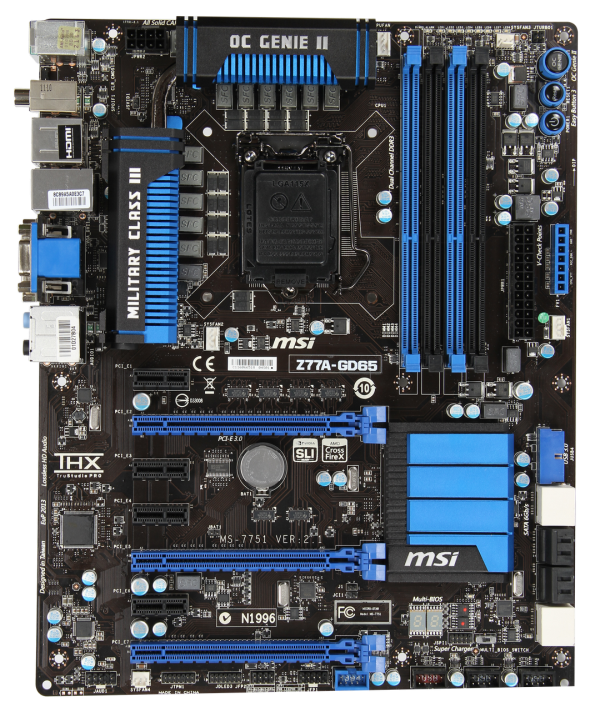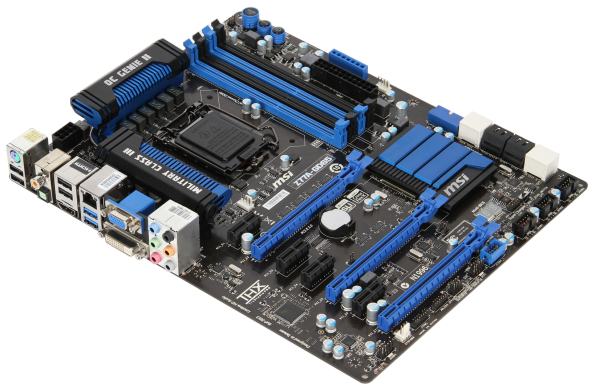Intel Z77 Panther Point Chipset and Motherboard Preview – ASRock, ASUS, Gigabyte, MSI, ECS and Biostar
by Ian Cutress on April 8, 2012 12:00 AM EST- Posted in
- Motherboards
- Intel
- Biostar
- MSI
- Gigabyte
- ASRock
- Asus
- Ivy Bridge
- ECS
- Z77
MSI Z77A-GD65—Visual Inspection
Whenever it comes to a motherboard comparison involving ASUS, Gigabyte or ASRock against an MSI board, the MSI board always tends to show a strong result—either in terms of price, performance or features. So when it comes to the new batch of motherboards for Ivy Bridge, it is fair to say that I expect a strong showing from MSI. For this preview, we have their Z77A-GD65, which will be one behind their future released GD80 that got attention back at CES for being Thunderbolt equipped.
The Z77A-GD65 is another motherboard in this roundup that comes in a black and blue livery. This time MSI have more of an excuse than others do as they have been using it for a fair while now. Using what is essentially a 10 + 2 phase power delivery, MSI are using somewhat beefier heatsinks than their rivals, connecting both via a heatpipe. The socket area is right up against Intel's minimum requirements from left to right, but there is some room to maneuver big air coolers from top to bottom. Around the socket there are at least four fan headers to use: one 4-pin CPU header between the top VRM and the memory slots, a 4-pin system fan header just the other side of the memory slots, a 4-pin to the bottom left of the socket area, and another 4-pin beside the 24-pin ATX power connector. A fifth fan header can be found at the bottom of the board.
Along the right hand side, we have the standard MSI trio of power/reset/OC Genie buttons, followed but a series of voltage checkpoints for overclockers. Aside from the 24-pin power connector and the system fan header, there is also a USB 3.0 header at right angles to the board, indicating its primary use is to the front of the case. Underneath this are the eight SATA ports—two SATA 6 Gbps from the PCH, four SATA 3 Gbps also from the PCH, and another two SATA 6 Gbps from an ASMedia controller.
As the power/reset/OC Genie buttons are at the top right, the bottom of the board has more room to fit in all the headers as needed—front panel audio, TPM, front panel headers and USB 2.0 headers. In terms of PCIe, MSI have done away with the PCIe to PCI bridge and focused purely on PCIe. We have an x1, x16 (x8 with dual GPU), x1, x1, x8, x1, and a PCIe 2.0 x4. In this instance, there is plenty of room for a dual GPU setup with PCIe slots to spare for any extras.
Also of note is the chipset cooler, which is very flat and large with minimal fins, perhaps suggesting that MSI is confident about their heatsink design. Underneath this is a two digit debug display, and a BIOS switch for changing between two BIOSes.
On the rear IO panel, I think MSI have been reasonable with what they have left in and what they have left out. From left to right, we have a combination PS/2 port, two USB 2.0 ports (black), a clear CMOS button, digital and coaxial SPDIF outputs, two more USB 2.0 ports (black), a HDMI port, gigabit Ethernet, two USB 3.0 ports (blue), D-Sub, DVI-D, and audio jacks.
Board Features
| MSI Z77A-GD65 | |
| Size | ATX |
| CPU Interface | LGA-1155 |
| Chipset | Intel Z77 |
| Power Delivery (CPU/iGPU) | 8 + 1 + 2 + 1 (VRM/VTT/GPU/SA) |
| Memory Slots |
Four DDR3 DIMM slots supporting up to 32 GB Up to Dual Channel, 1066-2667 MHz |
| Video Outputs | HDMI, DVI-D, D-Sub |
| Onboard LAN | Intel 82579V |
| Onboard Audio | Realtek ALC898 |
| Expansion Slots |
2 x PCIe x16 Gen3 (x16, x8/8) 1 x PCIe x16 Gen2 (x4) 4 x PCIe x1 Gen2 |
| Onboard SATA/RAID |
2 x SATA 6 Gbps (PCH), Support for RAID 0, 1, 5, 10 4 x SATA 3 Gbps (PCH), Support for RAID 0, 1, 5, 10 2 x SATA 6 Gbps (ASMedia ASM1061) |
| USB |
4 USB 3.0 ports (2 back panel, 2 from headers) 10 USB 2.0 ports (4 back panel, 6 from headers) |
| Onboard |
4 x SATA 6Gbps 4 x SATA 3 Gbps 1 x USB 3.0 Header 3 x USB 2.0 Headers 1 x IEEE1394 Header 1 x TPM Header 1 x Front Panel Audio Header Power/Reset Buttons OC Genie 5 x Fan Headers |
| Power Connectors |
1 x 24-pin ATX connector 1 x 8-pin 12V connector |
| Fan Headers |
1 x CPU Fan Header (4-pin) 4 x SYS Fan Headers (two 4-pin, two 3-pin) |
| IO Panel |
1 x Combo PS/2 Port 1 x Clear CMOS Button 1 x Coaxial S/PDIF Port 1 x Optical S/PDIF Port 4 x USB 2.0 2 x USB 3.0 1 x Gigabit Ethernet Audio Jacks 1 x HDMI 1 x DVI-D 1 x D-Sub |
| Warranty Period | 3 Years |
| Product Page | Link |
It is good to see an Intel NIC on this $180 MSRP motherboard. There are plenty of headers to go around. The only things missing where other motherboards may have better all-round functionality are a PCI slot, mSATA and on-board WiFi.













145 Comments
View All Comments
Zoomer - Tuesday, April 10, 2012 - link
So when is AMD buying them out and integrating this in their gfx cards / platform?neo55 - Sunday, April 8, 2012 - link
Will Z77 support two or three monitors simultaneously?GreenEnergy - Sunday, April 8, 2012 - link
You mean from the Ivy Bridge IGP?Well depends. (Its the same btw for H77, Z75 and Z77 etc.). You need to have 2 displayport if I remember correctly. So if you got for example DVI, HDMI and DP. Then 2 screens only. If you got DVI, DP, DP then 3. Or if you daisychain the DP?
dubyadubya - Sunday, April 8, 2012 - link
Listing fan header count and layout is useless if you do not test the functionality. Do they report RPM? Can they control fan speed? Does the fan control work with Speedfan etc. or only the software from the motherboard manufacturer? Several years ago many people including myself brought this to Anandtech's attention. At the time Anandtech stated they would include this missing info which they did. Trouble is the info was only included in one or two reviews before it was dropped. When I purchase a new motherboard I want to know this info. I have spent many hours searching for this info for each new build as most manufactures do not give detailed info even in the motherboard manual.IMO if a fan header exists it must have full functionality. If not the header should not be on the board. Motherboard manufactures need to pull their heads out of their asses. If Anandtech reported this info in reviews and gave negative reviews on boards with poor fan support the manufacturers would get the hint.
Nje - Sunday, April 8, 2012 - link
Yeah I would love to know this, particularly if the fan headers can control 3 pin fans as well (ie vary the voltage).ASUSTechMKT - Monday, April 9, 2012 - link
Primary CPU headers ( CPU and CPU OPT are fully controllable for 4 pin ) as the majority of CPU coolers are PWM for chassis headers ( 1-4 all allow for 3 pin and 4 pin fan control ).Zoomer - Tuesday, April 10, 2012 - link
Asus, can they be used with speedfan or is it BIOS/Asus software only?ASUSTechMKT - Monday, April 9, 2012 - link
This has been noted in the last couple of reviews. Specifically for ASUS we have spent considerable time putting quality fan controls on our boards all headers allow for 3 presets as well as min and max rotation and target temperatures. In addition with our software for this generation we offer full calibration per each header that can sense the min and max rotation and provide this information as well as sync this data to the profiles. Overall it is quite extensive make sure to check out our videos coming up which shows it in great depth.Arbie - Monday, April 9, 2012 - link
@dubyadubya - Look on the bright side: at least one manufacturer (Asus) takes fans seriously, and at least one reviewer (Anandtech) is even mentionng the fact.I have the same wants as you do, and have made the same requests, but be reasonable. These aren't full motherboard reviews! They don't even have the boards operable, much less any hands-on time with BIOS details.
And when they do have all that, a higher priority will be PCIe lanes and how many graphics cards can be stuffed in. That's because you can't run any modern games with only one board.
But then they might talk a little more about the fan controls... Let's hope. Again - be glad that even one vendor is paying attention and has included some controls to be talked about.
Cavalcade - Sunday, April 8, 2012 - link
With a slightly more than passing knowledge of rendering, and having spent a fair amount of time handling input in a game engine, I'm curious as to how Lucid came to the responsiveness numbers in the chart on page 3. The concept seems valid at first glance, but the numbers strike me as pure marketing fodder as opposed to solid and testable results.Also, this sort of technology seems far better suited to residing in the driver layer as opposed to yet another piece of middleware for PC gamers to contend with. We're already effectively blocked from the hardware, and forced to go through third-party graphics APIs (Direct3D/OpenGL).
Maybe it's a "you have to see it (feel it)" kind of thing, but from here you can color me skeptical.